By Samantha “Kitten” McComb
I grew up with Mega Man as a series near and dear to my heart, and it’s probably the series in all of gaming that most significantly impacted my taste. For Christmas this year, I’d put Mega Man III on a list of random old games for my parents to get me. I had the first two and had played the latter two before, but I’d never touched this particular entry before. They ended up choosing it, and I started playing it again last month.
Coupled with my television going out, replaying Mega Man III led me to find a new love for the Game Boy games. I bought IV and V to complete my collection, and felt like replaying them continuously, as well as writing about them. I beat each of without dying or using an E-Tank on the same run (III being the most difficult to do this on), so I got to know them pretty well. Below are entries on what I’ve written on each game. I tried to be as fair-handed as possible, but my passion for the series does show, so I might have been a little more generous than the average gamer.
– – – – – – – – – – – – – – – – – – – – – – – – – – – – – –

Mega Man: Dr. Wily’s Revenge is the first of the five Mega Man games exclusive to the Game Boy. It also happens to be the first that I played and one of only two that I played during my childhood. Like each of the first four games, it contains 4 robot masters from its NES counterpart and four from the sequel (meaning that Guts Man and Bomb Man never made it onto the Game Boy). Unlike its 3 successors, however, the latter 4 of the robot masters do not receive unique stages.
My initial impressions from playing it years ago weren’t incredibly positive. I loved nearly everything Mega Man at that age, including the Ruby Spears cartoon, but I just absolutely could not get into this game. For the most part, it was due to the high level of difficulty. Most levels had me incredibly frustrated and it took many long trips in the car before I eventually managed to beat it years later.
Playing it again, I’m still bit put off by its design. I was able to beat it without continuing, but I still found myself unable to appreciate it like I had always wanted to. The difficulty, although now much more manageable, was still enough to frustrate on quite a few occasions. Out of all of the classic series games I have played, I would likely label Dr. Wily’s Revenge as the most tedious and mechanical of all of them.
The pacing is constantly broken by having to stop and wait, whether it be by disappearing blocks, other timed traps or enemies with completely unreasonable amounts of health. In that effect, it is quite similar to the original NES entry, but I feel it is a slight bit more masochistic and grating to deal with. Take a look at Cutman’s stage and watch how many times the player stops moving. There is very little momentum.
An important thing to note is that the Mega Buster fires much more slowly to make up for the limitations of the Game Boy (and to compensate for screen size being much smaller). This means that during the many points where you’ll be taking down a tough enemy, it will feel much slower than on the NES. The lack of a charge shot means that you cannot be prepared for taking these enemies down quickly (unlike in the later Game Boy games in the series), so you really feel the break in pace.
 |
| 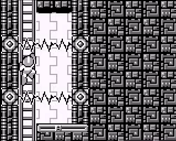 |
| 
Admittedly, space is used very effectively for a Game Boy game, especially given the size of the screen. The pacing of each stage also keeps them relatively small, but full of things to do. They thankfully did not try to recreate the NES stages on the Game Boy, and made them all originally designed (but similar, thematically). Unfortunately, at least in my opinion, most of levels involve stopping and waiting over and over again. There’s no slide in the game, and players who enjoy playing Mega Man games impatiently will likely find themselves either bored or angry.
Aesthetically and aurally, it translates Mega Man quite well onto the Game Boy. The music sounds almost exactly like it does on the NES and the sound effects do, as well. Visual level design is a tad bit bland, however, and I felt like there could have been more innovative theming (admittedly, the original NES game also suffered from this). The enemies look nice and generally match up to the theme of the level, but the backgrounds just don’t really cut it. I would have been more forgiving if this had been an earlier Game Boy title, but it was released in mid 91, which would give me higher expectations for it (for reference, Gradius: The Interstellar Assault was released within about two weeks of it, and looks much more impressive).
I am able to recognize the charm in the simplicity of a Mega Man game like this – it is very mechanical, it is very deliberately paced and it has a level of challenge to it that many fans of the genre crave. However, it is much too slow for my liking and becomes nearly abusive to the player late in the game, bringing in a lot of trial and error with significant punishment. Being only 6 stages in length, both of the last two stages are very “mean” in their design.
I would like to say that the game’s mechanical nature leads it to having a high replay value, but its pacing unfortunately ruins most of that. No matter how used to the game you are, you’re constantly going to be taking the game at a pace much slower than its brethren. I certainly do not want to call this bad design, as I feel like that would be an insult to players who enjoy very mechanical action-platformers, but I do wish to make clear it is not how I play Mega Man, which is quickly and perhaps a bit recklessly.
All in all, it’s a competent game, and in some ways does earn its place among the most classic of Game Boy games. However, I do find it hard to recommend to most Mega Man fans, and still feel like they could have done a much better job. When watching people on YouTube play (any) Mega Man, I am always bewildered when some people play the game in the most boring, rehearsed ways possible. I always felt one of the most important components of Mega Man was momentum, and I cannot identify at all with the seemingly large number of fans who will stop and pause the game to switch weapons only to kill a single, ignorable enemy (and then pause and switch back again; this disruption of flow always seemed ridiculous to me, and I only change when necessary or when it would be considerably faster). I like to speed through levels and almost exclusively use the buster.
Perhaps my perception of a good Mega Man game is much different from others’, which is why I am abstaining from using words like “mediocre” to describe Dr. Wily’s Revenge. However, making the first Game Boy entry this inaccessible (I believe a difficulty option like in Mega Man 2 would have done the game very well) is something I feel was a bit of a bad idea. It no doubt had a hand in kids like me losing interest in Mega Man on handhelds very quickly. I’m glad I came back to the handheld entries as an adult, however.
 |
|  |
|  |
|  |
| 
Rating: [3/5]
– – – – – – – – – – – – – – – – – – – – – – – – – – – – – –

Mega Man II is the sequel to Dr. Wily’s Revenge, releasing less than 5 months from its predecessor (the quality of the game suggests it may have been developed in that short a time, and not overlapped time with the original). It was the only one of the five games to be developed by a different company than the other four, and the disparity in quality is fairly obvious and immediately noticeable.
To begin with, the most stark difference that II has from its ilk is horrible sound. While I suppose points must be given for giving each level a new song (as opposed to most of the other Game Boy games, which largely recycle NES compositions), most of the levels sound very poor and often use ear-grating tunes that are just… unpleasant. I don’t wish to be so harsh, but give a listen to Metal Man’s theme and see if you agree with me. Music has always been one of the strongest points of the series, and I consider the series to define 8-bit music more strongly than any other game series (perhaps sans Castlevania). To have music this lackluster in Mega Man II is just unacceptable.
The sound effects are also off, particularly when picking up an 1up, energy pellet or E-Tank. Subtle changes like this make you realize how iconic a Mega Man game is; it was an odd feeling when I actually felt disappointing by the dinky sound effect when picking up an E-Tank in this game. Other tiny changes are noticeable and make the game feel lazy, such as being able to climb ladders while stunned, having buster shots occasionally pass through enemies when rapid-firing (or colliding at strange points) and having boss doors scroll very strangely.
The game’s level design is bizarre, and comes off as though it wants to be different from its NES counterpart, yet at the same time is afraid to. Crash Man’s (called Clash Man) level is perhaps the best example of this. It looks ugly and nonsensical and has very poor flow, both of these problems caused from taking poor queues from the original NES stage. Wood Man’s stage attempts to deviate by having a segment in the level that is halfway submerged, but using the Rush Marine adapter just acts as a shortcut through it (with zero challenge to it. I am not even sure why the Rush Marine can fire a buster shot in this game, as you never need to with it). Not that it matters, because there are TWO large energy pellets (enough to fully restore your life) in the two screens immediately after. The entire level is excessively easy, boring, and poorly designed.
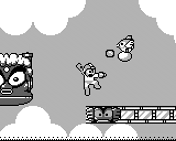 |
| 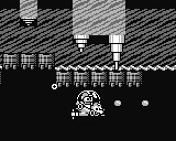 |
| 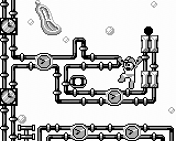
The final stage also features some inappropriate design for the series, with melting clocks being prominently featured. The Wily battle is very strangely scaled, giving him the appearance that he is very tiny. When I was a child, I merely sped through the game a single time and largely forgot about it, thinking that they had tried to compensate for Dr. Wily’s Revenge being too difficulty by making II too easy. Today, it is glaringly obvious that two very different groups of people worked on the two games.
To refrain from grinding on further minutia about the game (I could go on about the little things the game does wrong even longer than I already have), I think it would suffice to say that II is just missing the idea. It doesn’t have a very good understanding of what makes a good Mega Man game good, and it suffers greatly because of that. I don’t mean to make it out as though the game is irredeemable, it’s still “a fun Mega Man game on your Game Boy,” but it’s almost entirely forgettable and most recommendable due to what went wrong, rather than what went right.
From what I’ve gathered from reading the Wiki, Inafune decided to continue allowing the company that had developed Dr. Wily’s Revenge to make further entries in the series (The Game Boy games are the “Rock Man World” series in Japan). I find this bit of information worth pointing out because it reflects a Capcom that seems almost alien by their standards, today. Mega Man II sold quite well (proudly brandishing that it had sold over one million units on later copies of the game) and was produced rather quickly – for them to make a conscious decision to support quality over profit and convenience really shows how much the company has changed for the worse, and forgotten their more noble roots. Perhaps it is for the best the Blue Bomber is currently being ignored.
 |
|  |
|  |
|  |
| 
Rating: [2/5]
– – – – – – – – – – – – – – – – – – – – – – – – – – – – – –

Mega Man III seems like a weird marriage between the superior design of IV and V, which I’ll go into later, and the lingering, more masochistic mechanical design of the first Game Boy game (the 2nd was by a different company, I should remind you). Like most of the MM GB games, it features 4 robot masters from its NES counterpart and 4 more robot masters from the next numbered NES game (i.e. this one contained four MM3 bosses and four MM4 bosses). In addition to the levels being designed much differently (although sounding mostly the same), they often swap the scenery around. Stages that were indoors on the NES are now outdoors, and vice versa.
Visual design, in general, has been stepped up tremendously from Dr. Wily’s Revenge. To point out a single example, there’s a really awesome segment in Skull Man’s stage where you drop down into a cavern with glowing bones in the background that really impressed me. While the other levels don’t have segments that stand out quite as much as this, they do have segments that stand out. Spark Man’s stage is also quite busy-looking, and Gemini Man’s stage features animated vines in the foreground that Mega Man can actually scroll behind. The game looks very nearly as good as its two predecessors, which I consider two of the best looking Game Boy games, by far.
However, the game is a bit rife with a problems, too. Despite the stages being mostly well-designed (and certainly fun to play), I feel like the game occasionally forgets that it is on a Game Boy. You’re often forced into making jumps that feel uncomfortable given the size of the screen, and obstacles have somewhat poor placement. There are quite a few moments in the game (a few too many) that involve a giant, slow-moving enemy advancing at you with very large amoutns of health. You’re often forced to retreat a few steps to beat them (which can become a major problem, considering the game will respawn an enemy if its spawn point goes even slight off screen, much like the original Ninja Gaiden), or just crash into them (at substantial health loss) and continue. I suppose you’re expecting to use special weapons on them, but you don’t always have those and it’s not immediately apparent which will do enough damage in the time you have before collision.
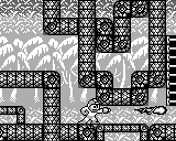 |
|  |
| 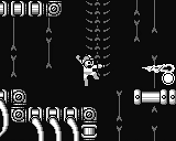
Boss fights are largely identical to their NES counterparts (or at least try to be, the difficulty is altered on a few, such as Shadow Man, who is now much easier), and the sprites are the same size as those in the NES game – this leads to bosses that don’t work very well, and turn into battles of attrition. A few bosses designed originally for the game work quite well, but the game only features a single Wily stage, so not many of them end up featured. The Wily Stage is very well designed, however. Its length is almost excessive, but its pacing is done well, so it works excellently from a marathon perspective. It also has one of the best tunes originally composed for the series.
Mega Man III is very much worth playing as a Game Boy enhtusiast or big fan of the Mega Man series, but it doesn’t do a lot that its two successors don’t do better. It does do a lot to set itself apart from its two prequels, however, which aren’t quite up to par. I feel like III is often the most neglected of the Mega Man Game Boy games, as it’s really good, but not quite “great,” and has the misfortune of being in the middle of the series. Given that the first two games are mediocre and very commonly owned and found, and the latter two games are both borderline “holy grails” for the Game Boy, nobody talks about III, which has an average price and is the average in quality for the 5 games (although it’s still worth talking about and worth playing!).
 |
|  |
|  |
|  |
| 
Rating: [4/5]
– – – – – – – – – – – – – – – – – – – – – – – – – – – – – –

Mega Man IV continues the quality Game Boy design laid down by its immediate predecessor. It also attempts to improve itself where it can, largely coming out a better game because of it. The format is still kept mostly the same (4 Mega Man 4 bosses, unique level, 4 Mega Man 5 bosses, unique level), but the inner workings have been tinkered with enough to provide a much more digestible game on the Game Boy.
Mega Man III’s biggest problems were its fairly oppressive difficulty and lingering struggle to really cram a full Mega Man onto such a portable system. These problems were interrelated, and were largely caused by the limitations of the hardware rather than any sort of poor design. Maintaining a similar resolution to the NES sprites doesn’t leave the game with a great deal of breathing room, and changing the resolution would lose a great deal of charm and detail that goes into the overall design of a Mega Man game.
III was a very valiant attempt in getting the most of this limited space, but IV pushes things a step further. While you still have the ever-present HUD displaying your life, 1-ups and weapon energy taking up a chunk of the bottom of the screen (I omit these from screen shots – Many Game Boy games have them to allow more detail on the screen than would otherwise be allowed), they’ve further designed the levels around the limited amount of space. While the design could arguably still be considered a tad claustrophobic, it gets the job done remarkably well.
Rather than just translating Mega Man to Game Boy, IV really manages to show that the developers have been steadily carving out their own design and perfecting their own pacing. They’re still, without a doubt, all very solid Mega Man games, but the minor tweaks all begin to shine brightly in IV. The slightly adjusted physics, the rate of fire for the mega buster, the length of the levels compensating for the relatively small amount displayed on screen at once… IV really strikes the player with an awareness that they’re playing a unique game every bit as competitive for your attention as the NES games.
IV’s presentation is incredibly solid, and it lets you know this right off the bat with a rather cinematic opening. Even the level select screen has been changed from the NES standard and allows you to move the robot masters along a wheel. Each time you highlight a new robot master, a detailed picture of the environment of the level he occupies will be displayed. Miniature cutscenes also help season the game’s rich presentation, setting the mood and further engaging the player into the game.
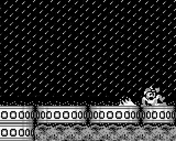 |
| 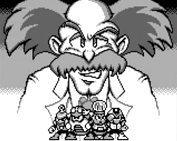 |
| 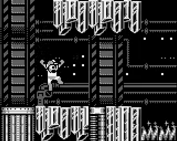
Each of the Game Boy games up to this point had featured a “Mega Man Killer” robot, who would act as a single boss fight late in the game, and was one of the unique elements to the Game Boy games. IV’s “Mega Man Killer,” Ballade, features a significantly increased presence in the game, appearing in both the opening and ending and being in two separate boss fights during the game. His appearance as an antagonist helps make IV a distinct game, and also serves to give the player a greater sense of purpose. Most of these changes in presentation are subtle, but it’s delightful how they add so much depth to the game without fettering it.
Difficulty in IV is toned down from the previous installment, but done so in a way that it still retains a good sense of challenge to the player looking for one. Most of the difficult platforming is now centered around stage-specific gimmicks (such as the flowing water in Toad Man’s stage or the mobile drill platforms in Stone Man’s stage) rather than increasingly demanding and difficulty timed jumps, which both alleviates frustration and helps make IV a game to come back to.
A shop has also been introduced, which players may purchase items from (such as E-Tanks or weapon energy refills) to help assist them. P-Chips (the currency for the shop) are found randomly in small increments from enemy kills, or by accessing more difficult to reach areas of certain levels. While I felt the shop fettered the game a bit in 7, 9 and 10, collecting P-Chips in IV is satisfying because it helps serve to accent the level design in such a way that helps the player realize that space is almost always effectively used within the game. Levels don’t just feel long, they also feel relatively spacious.
Levels are not only better designed in terms of how they use space, but are also designed to a more visually impressive degree. Backgrounds feel more occupied, foregrounds feel more vibrant and you usually have either one or the other with some sort of animation. The visual design of the game, in general, pushes the Game Boy to its limits and is sure to impress anyone familiar with the hardware. Just take a look at Crystal Man’s new stage, which takes place inside a mobile fortress (all 4 of the Mega Man V bosses take place somewhere in the fortress). It has excellent theming (making it look like Crystal Man has intentionally crystallized the areas closest to his sanctum) and is just very impressive looking.
There are even quite a few subtle visual touches in some levels that might go unnoticed – such as Mega Man’s slide leaving a splash of water instead of a cloud of dust when in the rain, during Toad Man’s stage. The sound design is still excellent, with the reproduced tunes sounding just like their NES counterparts and the original tunes sounding better than ever (and just as well in theme with what it’s established a Mega Man game should sound like). The new Wily Boss theme is particularly chilling.
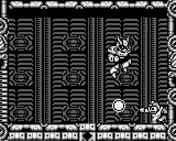 |
|  |
| 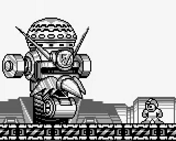
Although it does stick largely to formula, IV makes an interesting, but small change in mechanics that affects how one plays the game. Firing a fully charged shot will now cause the player to experience recoil and bounce up and back just a slight bit. While this is a fairly innocuous change during levels with less difficult platforming, it introduces a bit of risk and reward to levels with more precarious platforming. The effect can cause a player to fall off a small ledge if they’re situated near the end of it, but, at the same time, the charge shot is a safety net when fighting bigger enemies.
This causes the player to need to make a conscious decision whether they’ll keep a shot charged before jumping to another platform. While you typically won’t need a charge shot around smaller platforms (enemies placed near them usually die in a single buster shot), putting your brain on autopilot in these situations can prove to be quite perilous. Jumping onto an unsafe platform with a shot fully charged provides a greater sense of the fear of the instant death below, and the mere fright of falling off will typically cause the player to panic a little bit and play with less concentration.
Combine the recoil with the smaller screen space, and you have a mechanic that is far better used and suited to the Game Boy than the NES. This type of design is prevalent throughout the entire game, limited space being used to make certain enemies and situations either more intimidating or played differently. Even though 8 of the boss fights are more or less copies of NES boss fights, you’re still given enough room to navigate to feel as though each hit you take is your own fault.
Mega Man IV starts off strongly, maintains its strength and ends with what I would call the best Wily fight in the entire series (not just on Game Boy). While it does have a few weaknesses here and there (there are a few moments that still feel a bit unfair, the falling rock platform is recycled a little too much, E-Tanks can be farmed and are easily abused to make challenging boss fights too easy, collecting letters to access the final level is silly), and it still has a few problems with slowdown (it gracefully comes out of slowdown, so it doesn’t bother me, but I know some people strongly dislike slowdown in any form), the game’s biggest weakness is that it’s forced to reuse elements from the other games. Despite its excellent design and strong signs of originality, it is still hampered most greatly by the fact you’ve fought these bosses and seen most of these enemies before.
I feel it speaks highly of the game’s quality that the harshest criticism I can bring against it is that it has recycled elements. While it can fetch somewhat of a hefty price, I consider it to be almost essential playing for both Mega Man and Game Boy enthusiasts. Even if you didn’t like the latter half of the released NES games, I still feel that IV possesses enough clever and unique design for it to be worth looking into.
 |
|  |
|  |
|  |
| 
Rating: [5/5]
– – – – – – – – – – – – – – – – – – – – – – – – – – – – – –

Mega Man V, putting it right out there, is what I feel is not only the greatest Mega Man game on the Game Boy, but perhaps the system’s very magnum opus. I’m not going to beat around the bush, here, it’s definitely what I consider an excellent game. Each game in the little handheld series feels like it was leading up to this one slice of gaming excellence, and to say it doesn’t disappoint would be a criminally misleading understatement.
Each of the previous games suffered to at least small degrees for being unable to break entirely free of the fact that they were still having to reuse enemies, themes and bosses from the NES games. Their levels still featured original designs and they were all unique games, each worth playing for different reasons (well, except maybe II, aside from to see how things were done wrong). But, to some measure, you felt like you had already fought these battles, because what was waiting for you at the end of most of them was someone you’d already beaten before, in a stage reminiscent of somewhere you’d already been.
Mega Man V is the game that fans of the GB series were waiting for. Every boss was unique and interestingly themed, every enemy was new and exciting, every piece of music an original composition. For one game, we finally got to see everything that this team of talented developers was capable of, and they wasted no opportunity in showing us the best they could.
One of the many things that was exciting about V’s freshness was that the robot masters are the only set in the entire classic series to… well, not actually be “robot masters.” Instead, they’re “Stardroids,” all devoid of the eponymous “Man” in their title that fans of the expansive series had become so accustomed to. There are nine in total, with four of them having selectable stages before the format’s now standard, obligatory halfway stage, and the other four being selectable from that point onward.
Each of the nine are named after a different planet in our solar system, with Terra (i.e. Earth) acting like this game’s “Mega Man Killer” robot (in that he appears as a boss before the final stage). The plot (yes, there really is one, check out the cool intro) begins with Mega Man being assaulted out of the blue and torn apart by Terra, his mega buster unable to cause any damage to the mysterious foe. Mega Man is forced into repair, and the Stardroids, revealed to be made from an alien metal, more or less take over the planet during this time. Upon finishing repair, Mega Man is greeted with a new robot companion, Tango, who may be summoned much like Beat to help defeat various enemies on screen. Tango, although cute, is unfortunately not particularly useful.
While his new feline buddy may not be much of a game changer, during repairs, the Super Mega Buster (the charged shot) was modified by Dr. Light into the “Mega Arm.” In addition to serving as a plot device so that Mega Man may now damage the Stardroids, it offers as an opportunity to change the fundamental mechanics of the charge shot. Halfway charging it makes you launch your arm a short distance and deal two bars of damage (a halfway charged shot, before, would only do a single bar), and fully charging it flies it most of the distance of the screen before returning to you, dealing the full three bars the charge shot has classically done.
This change in basic mechanics is accented the limited screen size of the Game Boy – by changing the charge shot into somewhat of a boomerang projectile, you take advantage of the fact that it has less room to travel and return to, making it more exciting to use than it would be on an NES game. Mega Man cannot fire the buster at all or begin charging again until the arm returns to him, which helps incentivize using both the buster and charge shot in alternating degrees. Before V even starts, the game is already established as being more willing to rock the boat than any game in the series has since 2 on the NES.
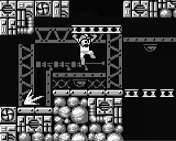 |
| 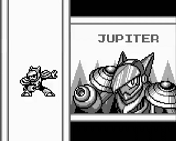 |
| 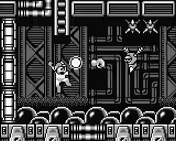
The shop from the previous game returns, although you may now purchase two permanent upgrades to the Mega Arm in addition to the old assortment of replenishment items and the equalizer. The first of the upgrades allows you to randomly have the Mega Arm “latch” itself onto an opponent, repeatedly punching them for bonus damage. This upgrade is nice to have – when it works, it’s pleasantly helpful, but the random nature of the upgrade fortunately keeps it so that it may not be abused, keeping the player’s skill sharp. The second upgrade allows Mega Man to grab items and bring them back over to him (much like Ring Man’s weapon), which proves to be surprisingly useful in the latter 4 of the Stardroid’s selectable stages (making it wise to purchase ASAP).
Both of these upgrades help enhance the game without making it a great deal easier. They assist the player in feeling more powerful without really insulting their skill level, something I feel the Mega Man X games did a really poor job of by introducing too many upgrades. While E-Tanks are still around to help newer and less experienced players, the game is built very well around beating it in a run on a single life without using them. It provides a fair, well-rounded challenge with excellent pacing and extremely few moments where you’d be tempted to blame the game of being cheap. Checkpoints are also positioned to stress this design, being positioned more toward the first 3rd of the level, rather than the halfway point.
The level design in V is superb. Each level features its own unique platforming gimmick and several levels feature original, giant minibosses, making them all exciting to play for the first time and very inviting to replay. Venus’ stage features neat things like bubbles to adjust jump height and waterfalls to flush the player into a death trap. Pluto’s stage, on the other hand, features a falling platform that drops based on proximity to it, rather than position on top of it, making it act alternatively as a dangerous, falling ceiling (the level cleverly puts it to use both ways, surprising the player the first time it drops from the ceiling and damages them). Every stage has something cool like this, and when it’s not entirely original, it’s generally at least a new take and always well done.
Each stage also features clever theming around its robot master. Ares, the god of war in Greek mythology, was known as Mars to the Romans. Mars’ design, in the game, is the most warlike of all the Stardroids, and his level fits this theme by looking like a factory built for making war machines, featuring mines placed periodically throughout it with enemies that both and are shaped like missiles. Mercury is based partially on the chemical element of mercury, being able to change into liquid metal and back into solid form. The planet Neptune is known for being freezing cold and having strong winds, so Neptune, himself, has avian features and can fly, while his level eventually features ice hazards. The theming is sometimes subtle, sometimes not, but it’s generally pretty clever in how it’s done and makes the game really stand out.
The levels all make excellent use of space and easily demonstrate the best design of the handheld series. Each inch of the level gets used up, and some of them even contain special, hidden items worth backtracking to find on alternate paths (collecting all of these lets you buy a special item for free at the shop, which reduces weapon energy consumption by half. Most Game Boy games tend to remind you of their limits constantly, whereas Mega Man V might actually make you look at the NES games and feel like they’re a little blank. Both the foreground and background are always occupied and frequently animated, making them all visually outstanding. Some of the new enemies only appear once or twice within specific stages, helping to make them all different. Even without full color detail, like the NES games, V’s levels stand out in a way that’s just as memorable as the best stages in all of Mega Man, both aesthetically and functionally.
The music, as mentioned earlier, is entirely original, and among the best soundtracks in the series. While you don’t quite get tunes reaching the greatness of either Mega Man 2 or 3, I think it would be fair to say it’s not terribly far behind either of them with compositions that match or exceed the quality of those in the latter half of the NES series. Everything has that classic “Mega Man” sound to it, where it sounds like something identifiable as being from the series almost immediately.
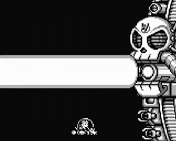 |
| 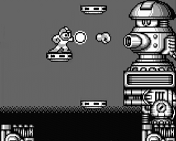 |
| 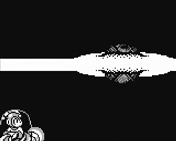
The first half of the selectable levels in the game and the mid-game level both take place on Earth, with Mega Man repelling the attacking Stardroids. The second half of the selectable levels take place in space, with Mega Man taking the fight to the Stardroids’ own space stations and defeating their newly formed army, culminating in a fight against Terra. Upon defeating him, it’s revealed that Wily (surprise, surprise) is supposedly behind everything once again as a gigantic, Death Star-esque space station with his trademark skull on it slowly looms into view before firing on our protagonist. Rather than simply teleporting onto the new fortress, the player actually plays a space shooter stage while piloting Rush, complete with a gigantic boss that actually causes the screen to scale out.
The single, gigantic Wily stage is excellently themed. It features a foreboding, tense music that build ups a “final battle” feeling, as well as multiple secrets and a few branching paths. Throughout the level, you come across capsules containing copies of the Mega Man Killer robots from the previous games, fighting each of them a final, single time along the way. You’ll also find one of the enemies from a previous stage repurposed with a “Joe” robot head, suggesting Wily had been helping build the Stardroid army. Everything about the way the level is structured and themed makes it feel like they intended for this to be the last game in this outstanding, handheld series, and the final battle does is probably my favorite in the entire Mega Man series.
I said that IV had the best Wily fight in the entire Mega Man series, and I still maintain that. The reason this doesn’t contradict what I just said is because the final boss isn’t actually Wily. Upon defeating the evil doctor, it’s revealed that he had actually found and awakened the Stardroids, and is now awakening their leader, Sunstar. Wily presumes he’ll be able to control this “doomsday” robot, who somewhat predictably, immediately betrays him. On the same health bar you just finished all 4 forms of Wily’s robot on, you have a final showdown with Sunstar, who is easily the most difficult boss in the game.
Defeating him leaves him crippled, with Mega Man quickly asking him to take his arm so that he may be taken back to Dr. Light’s for repairs. Sunstar, being a weapon built specifically for genocide of all lesser (non-robotic) lifeforms, is confused by the gesture, asking why Mega Man would show sympathy. The dialogue is short, but a bit touching, as Sunstar seems to realize the value of all life only too late. His reactor has gone critical, and the resulting explosion will take the whole fortress down with him. He commands his fellow robot to leave safely, and Mega Man escapes while looking back on the fortress as it explodes.
The ending takes on a melancholic tone with our hero looking back on his adventure safe on Earth, thoughtfully sitting on a log and looking up at the stars. He begins to journey off, before being attacked by Wily, the villain having barely survived the events of what happened. Wily’s saucer is trashed and overloads, leaving him once again begging for Mega Man’s forgiveness before running off. While the game does end on a somber note, it’s lighthearted enough to have everything “back the way it was.” This urges the player to look back on all their experiences with Mega Man, nostalgically recalling all their 8-bit adventures alongside our hero.
While Mega Man V might have been the end of the 8-bit era for Mega Man, it ends that era on as high a note as conceivably possible. I’d personally rate the game as the second best game in the entire Mega Man series up to its release date (you can’t beat Mega Man 2), and consider it essential playing for any fan that has missed out. It might rack up a relatively high price, but it’s certainly worth it.
 |
|  |
|  |
|  |
| 
Rating: [5/5]
– – – – – – – – – – – – – – – – – – – – – – – – – – – – – –
So, there you have it, my thoughts on all five games in this rad little series. In Japan, these games went under the “Rock Man World” title, to help distinguish them from the NES games. I feel like one of the reasons that the the later games in the series never got the recognition they deserved in the US was partially because of their titling. Naming almost exactly after the NES games fed into this mentality I believe people had back then that if they owned “Mega Man on the Game Boy,” why did they need to own it 5 times?
Portable gaming seemed to be more of a novelty back then, and people seemed to look at a lot of handheld series like novelty, tiny versions of games they already loved to burn time on trips. Despite the Game Boy not being replaced by a newer model until 1998, almost all of the games on the console considered by quality by GB enthusiasts were released in 1994 or prior. This suggests a loss of enthusiasm for original content, especially given that Mega Man: Dr. Wily’s Revenge and Mega Man II were the only two games in the series later reprinted in 1996 (I believe) on the “Player’s Choice” program.
I strongly suggest giving the series a shot, but if you end up buying them, make sure that you don’t play III, IV or V on the old brick or the pocket. They’re incredibly detailed games, and they become somewhat blurry messes on either of those, regardless of how many times you adjust the contrast. I love the Pocket a lot, it’s excellent for games with stark contrasts, but it just doesn’t do most of this series justice.
While I do love the series, one of my greatest disappointments was that none of the robot masters from Mega Man 2 got a stage in Dr. Wily’s Revenge, and the ones that appears in Mega Man II, well, you saw what I wrote about that game. We didn’t get any reproduced MM2 tunes on the Game Boy, and saw only half of 3’s robot masters getting them. I feel like this was a seriously wasted opportunity, but what can you do about it, eh? Anyway, I hope you’ve enjoyed what I’ve written, and also hope it convinced some of you out there that these games are worth looking into.